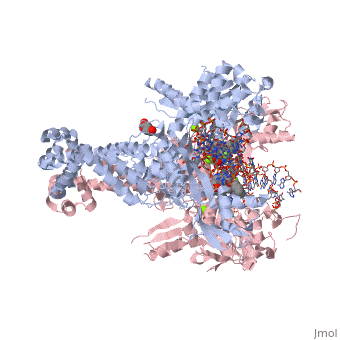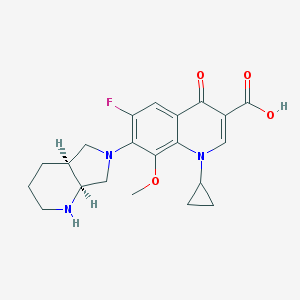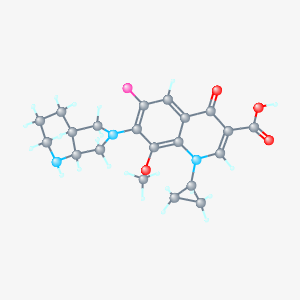Avelox (moxifloxacin)
From Proteopedia
| Line 1: | Line 1: | ||
<StructureSection load='2xkk' size='340' side='right' caption='Crystal structure of Moxifloxacin, DNA and a Baumannii Topo IV' scene=''> | <StructureSection load='2xkk' size='340' side='right' caption='Crystal structure of Moxifloxacin, DNA and a Baumannii Topo IV' scene=''> | ||
== Structure == | == Structure == | ||
| - | Moxifloxacin is a synthetic antimicrobial fluoroquinolone with the molecular formula C<sub>21</sub>H<sub>24</sub>FN<sub>3</sub>O<sub>4</sub>. It has an average molecular weight of 401.438 g/mol '''<ref name="pubchem">14614666</ref>'''. Fluoroquinolones are organic compounds categorized as a quinoline, aromatic ring with a substituted carboxyl group at one or more positions, as well as a fluoride as a central part of the compound | + | Moxifloxacin is a synthetic antimicrobial fluoroquinolone with the molecular formula C<sub>21</sub>H<sub>24</sub>FN<sub>3</sub>O<sub>4</sub>. It has an average molecular weight of 401.438 g/mol '''<ref name="pubchem">14614666</ref>'''. Fluoroquinolones are organic compounds categorized as a quinoline, aromatic ring with a substituted carboxyl group at one or more positions, as well as a fluoride as a central part of the compound '''<ref> https://drugsdetails.com/moxifloxacin/#Pharmacophore_structure_Information_about_the_chemical_structure_of_the_drug</ref>'''. The compound is able to accept eight hydrogen bonds and donate two '''<ref name="pubchem">14614666</ref>'''. The structure of the drug can also be found as a form of a monohydrochloride salt '''<ref> https://drugsdetails.com/moxifloxacin/#Pharmacophore_structure_Information_about_the_chemical_structure_of_the_drug</ref>'''. |
[[Image:Moxiflox.png]]<ref>14614666</ref> | [[Image:Moxiflox.png]]<ref>14614666</ref> | ||
| Line 10: | Line 10: | ||
Moxifloxacin is an antibiotic that works by inhibiting the function of two bacterial enzymes, topoisomerase II (DNA Gyrase) and topoisomerase IV, both of which are necessary for bacterial DNA replication. (6) DNA Gyrase works by inducing supercoils in DNA, and by unwinding DNA during replication, thus relieving torsional stress as helicase separates the double strand. '''<ref name="ncbi">NBK21703</ref>''' Topoisomerase IV causes decatenation, the unlinking of strands of tangled DNA, a function also necessary for DNA replication. (8) Moxifloxacin is taken up by human phagocytic leukocytes, such as neutrophils and macrophages, where it remains active against obligate intracellular bacterial pathogens '''<ref> http://aac.asm.org/content/43/1/12.full </ref>'''. Moxifloxacin, like other quinolones, may be able to enter bacterial cells through porins, which are small beta-barrel channels through their membranes '''<ref> https://www.ncbi.nlm.nih.gov/pmc/articles/PMC2696358/ </ref>'''. Moxifloxacin can then bind directly to its target, topoisomerase. Topoisomerases work by binding to a <scene name='75/756549/Dna_backbone/1'>DNA</scene> segment, called a G segment, and simultaneously binding a second DNA segment called the T segment. Topoisomerase cleaves the G segment, passes the T segment through the cleaved G segment, and then ligates the G segment back together. Topoisomerases require a magnesium ion for the cleavage of the G segment. Moxifloxacin prevents the action of topoisomerases by coordinating two bonds to a serine and a glutamic acid present on the enzyme using the <scene name='75/756549/Magnesium/3'>magnesium ion</scene> and associated water molecules. By this mechanism, Moxifloxacin is able to modulate the activity of the bacterial topoisomerase '''<ref> http://vanderbilt.edu/vicb/DiscoveriesArchives/combatting_antibiotic_drug_resistance.html </ref>''' | Moxifloxacin is an antibiotic that works by inhibiting the function of two bacterial enzymes, topoisomerase II (DNA Gyrase) and topoisomerase IV, both of which are necessary for bacterial DNA replication. (6) DNA Gyrase works by inducing supercoils in DNA, and by unwinding DNA during replication, thus relieving torsional stress as helicase separates the double strand. '''<ref name="ncbi">NBK21703</ref>''' Topoisomerase IV causes decatenation, the unlinking of strands of tangled DNA, a function also necessary for DNA replication. (8) Moxifloxacin is taken up by human phagocytic leukocytes, such as neutrophils and macrophages, where it remains active against obligate intracellular bacterial pathogens '''<ref> http://aac.asm.org/content/43/1/12.full </ref>'''. Moxifloxacin, like other quinolones, may be able to enter bacterial cells through porins, which are small beta-barrel channels through their membranes '''<ref> https://www.ncbi.nlm.nih.gov/pmc/articles/PMC2696358/ </ref>'''. Moxifloxacin can then bind directly to its target, topoisomerase. Topoisomerases work by binding to a <scene name='75/756549/Dna_backbone/1'>DNA</scene> segment, called a G segment, and simultaneously binding a second DNA segment called the T segment. Topoisomerase cleaves the G segment, passes the T segment through the cleaved G segment, and then ligates the G segment back together. Topoisomerases require a magnesium ion for the cleavage of the G segment. Moxifloxacin prevents the action of topoisomerases by coordinating two bonds to a serine and a glutamic acid present on the enzyme using the <scene name='75/756549/Magnesium/3'>magnesium ion</scene> and associated water molecules. By this mechanism, Moxifloxacin is able to modulate the activity of the bacterial topoisomerase '''<ref> http://vanderbilt.edu/vicb/DiscoveriesArchives/combatting_antibiotic_drug_resistance.html </ref>''' | ||
== Human uses of Moxiflacin == | == Human uses of Moxiflacin == | ||
| - | Moxifloxacin is an artificial antibacterial agent that is designed for oral and intravenous administration. It belongs to the category of drugs called fluoroquinolone antibiotics that is used to stop the growth of bacteria by inhibiting bacterial topoisomerase enzymes. While humans produce these same enzymes, human topoisomerase do not have the serine and glutamic acid residues needed for the action of the drug '''<ref> http://vanderbilt.edu/vicb/DiscoveriesArchives/combatting_antibiotic_drug_resistance.html </ref>'''. It is prescribed to treat various numbers of infections that are caused by gram-positive and gram negative bacteria, which results in a number of diseases such as acute flare-ups of chronic bronchitis, pneumonia, acute bacterial infection of the sinuses, complicated intra-abdominal infections and pelvic inflammatory disease(1). Moxifloxacin has been recently found to have another great advantage that includes treatment of dermatologic pathogens on the skin. It has a resistance towards pathogens that occur due to wounds caused by human and animal bite. Moxifloxacin can be used for a number of treatments; however, its use should be carefully administered in serious infections because it can lead to serious side effects, | + | Moxifloxacin is an artificial antibacterial agent that is designed for oral and intravenous administration. It belongs to the category of drugs called fluoroquinolone antibiotics that is used to stop the growth of bacteria by inhibiting bacterial topoisomerase enzymes. While humans produce these same enzymes, human topoisomerase do not have the serine and glutamic acid residues needed for the action of the drug '''<ref> http://vanderbilt.edu/vicb/DiscoveriesArchives/combatting_antibiotic_drug_resistance.html </ref>'''. It is prescribed to treat various numbers of infections that are caused by gram-positive and gram negative bacteria, which results in a number of diseases such as acute flare-ups of chronic bronchitis, pneumonia, acute bacterial infection of the sinuses, complicated intra-abdominal infections and pelvic inflammatory disease(1). Moxifloxacin has been recently found to have another great advantage that includes treatment of dermatologic pathogens on the skin. It has a resistance towards pathogens that occur due to wounds caused by human and animal bite. Moxifloxacin can be used for a number of treatments; however, its use should be carefully administered in serious infections because it can lead to serious side effects, '''<ref> https://drugsdetails.com/moxifloxacin/#Pharmacophore_structure_Information_about_the_chemical_structure_of_the_drug</ref>''' such as acute allergic reactions, diarrhea, and connective tissue problems, muscle pain, depression, agitation, renal problems and confusion (4). Therefore, it should be used exclusively for infections that cannot be treated with alternate safer antibiotics. |
Revision as of 21:53, 17 April 2017
| |||||||||||
References
- ↑ 1.0 1.1 1.2 14614666
- ↑ https://drugsdetails.com/moxifloxacin/#Pharmacophore_structure_Information_about_the_chemical_structure_of_the_drug
- ↑ https://drugsdetails.com/moxifloxacin/#Pharmacophore_structure_Information_about_the_chemical_structure_of_the_drug
- ↑ 14614666
- ↑ 14614666
- ↑ https://livertox.nlm.nih.gov//Moxifloxacin.htm
- ↑ https://livertox.nlm.nih.gov//Moxifloxacin.htm
- ↑ 8.0 8.1 7868402
- ↑ http://aac.asm.org/content/43/1/12.full
- ↑ https://www.ncbi.nlm.nih.gov/pmc/articles/PMC2696358/
- ↑ http://vanderbilt.edu/vicb/DiscoveriesArchives/combatting_antibiotic_drug_resistance.html
- ↑ http://vanderbilt.edu/vicb/DiscoveriesArchives/combatting_antibiotic_drug_resistance.html
- ↑ https://drugsdetails.com/moxifloxacin/#Pharmacophore_structure_Information_about_the_chemical_structure_of_the_drug
(1)https://pubchem.ncbi.nlm.nih.gov/compound/moxifloxacin#section=Chemical-and-Physical-Properties (2)https://drugsdetails.com/moxifloxacin/#Pharmacophore_structure_Information_about_the_chemical_structure_of_the_drug (3)https://livertox.nlm.nih.gov//Moxifloxacin.htm (4)https://www.drugs.com/avelox.html (5)https://www.ncbi.nlm.nih.gov/pubmed/7868402 6. https://www.drugbank.ca/drugs/DB00218 7. https://www.ncbi.nlm.nih.gov/books/NBK21703/ 8.https://academic.oup.com/nar/article/44/10/4528/2516939/How-topoisomerase-IV-can-efficiently-unknot-and 9. http://aac.asm.org/content/43/1/12.full 10. https://www.ncbi.nlm.nih.gov/pmc/articles/PMC2696358/ 11.http://vanderbilt.edu/vicb/DiscoveriesArchives/combatting_antibiotic_drug_resistance.html Photographs :Ginsburg AS, Hooper N, Parrish N, Dooley KE, Dorman SE, Booth J, Diener-West M, Merz WG, Bishai WR, Sterling TR: Fluoroquinolone resistance in patients with newly diagnosed tuberculosis. Clin Infect Dis. 2003 Dec 1;37(11):1448-52. Epub 2003 Nov 4.



